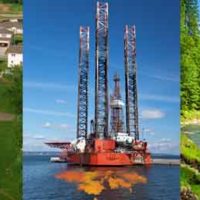THE IMPACT OF U.S. POPULATION GROWTH ON GLOBAL CLIMATE CHANGE
- Edwin S. Rubenstein
- January 17, 2017
- Forum Papers
- Forum Paper
- 0 Comments
![]() Your gift helps publish and distribute materials like this.
Your gift helps publish and distribute materials like this.
Click here for a downloadable, printable PDF version
THE IMPACT OF U.S. POPULATION GROWTH ON GLOBAL CLIMATE CHANGE
An NPG Forum Paper
by Edwin S. Rubenstein
EXECUTIVE SUMMARY
On the first Earth Day, April 22, 1970, the nation paused to consider the impact of human activity on the global environment. The greatest threat – as seen that day – was the prospect that future generations would run out of food, fuel, and natural resources. Neither global warming nor population growth was on the environmental radar.
The following predictions were made that day:
- Paul Ehrlich, author of The Population Bomb, predicted that 4 billion people – including 65 million Americans – would starve to death between 1980 and 1989.
- Life magazine wrote: “…by 1985 air pollution will have reduced the amount of sunlight reaching earth by one half.”
- Ecologist Kenneth Watt said: “The world has been chilling sharply for about twenty years. If present trends continue, the world will be about 4 degrees colder for the global mean temperature in 1990, but 11 degrees colder in the year 2000. This is about twice what it would take to put us into an ice age.”
- Watt also stated: “By the year 2000, if present trends continue, we will be using up crude oil at such a rate… that there won’t be any more crude oil.”
None of these apocalyptic prophecies came to pass:
- Mass starvation was averted by the development of high-yielding crop varieties, new irrigation infrastructure, modern management techniques, synthetic fertilizers, and other advances in agricultural technology. The “Green Revolution” lowered food prices throughout the world, while reducing the amount of land that would have been deforested for agricultural purposes. Greenhouse gas emissions are considerably lower today because of these advances.
- Global dimming gave way to a “brightening” trend after passage of the Clean Air Act in 1970. The two pollutants thought to prevent sunlight from reaching Earth – particulates and sulfur dioxide emissions from aerosol – fell 80% and 53%, respectively, between 1970 and 2006. By 1975, the masked effects of trapped greenhouse gases on global warming finally started to emerge and have dominated ever since2.
- Global cooling? Another false alarm, the result of a slight downward blip in temperatures from the 1940s to the early 1970s and press reports that ignored a rapidly-growing body of scientific literature projecting global warming due to greenhouse gas emissions.
- Increased fuel efficiency standards for automobiles, appliances, and building codes have cut oil consumption by about 50% below what would have been the case under pre-1970 standards. The only “shortage” in the 2016 oil market lies in the capacity of tanks available to store excess oil.
In retrospect, the 1970s was a Golden Age for conservation – a period when most Americans believed that changes in our consumption habits along with new energy-saving technology could control, or even reverse, the degradation of our natural environment. January 1, 1970 was a watershed moment. On that day President Nixon signed the single most important environmental statute in American history: the National Environmental Policy Act (NEPA).
The new law ordered federal agencies to conduct Environmental Impact Statements (EISs) for any future actions – e.g., construction projects, programs, permits – that might “significantly” affect environmental quality. Unfortunately, NEPA never ordered agencies to study the environmental impact of carbon dioxide (CO2), the greenhouse gas associated with global warming.
Anthropogenic global warming – warming caused by human activities – comes from the CO2 generated by burning carbon-based fuels, principally coal, oil, and natural gas, along with deforestation and soil erosion.
Continue reading the full Forum paper by clicking here.
Ed Rubenstein, president of ESR Research, is an experienced business researcher, financial analyst, and economics journalist. He has written extensively on federal tax policy, government waste, the Reagan legacy, and – most recently – on immigration. He is the author of two books: The Right Data (1994) and From the Empire State to the Vampire State: New York in a Downward Transition (with Herbert London). His essays on public policy have appeared in The Wall Street Journal, The New York Times, Harvard Business Review, Investor’s Business Daily, Newsday, and National Review. His TV appearances include Firing Line, Bill Moyers, McNeil-Lehr, CNBC, and Debates-Debates. Mr. Rubenstein has a B.A. from Johns Hopkins and a graduate degree in economics from Columbia University.

